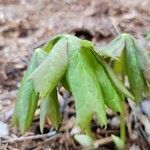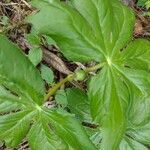An erect, 1-stemmed may-apple herb. It often forms colonies. There are creeping underground stems and thick fibrous roots. It keeps growing from year to year. It grows 60 cm high and spreads 60 cm wide. It produces one or two, large lobed leaves. These are 30 cm across and have 3-9 lobes. They turns orange brown with maturity. The flowering stem has 2 or 3 leaves or can be leafless. The flowers are white. They occur singly and are nodding and cream. The fruit are lemon shaped. They are yellow. They are edible.
Radical lvs scattered, with a stout, erect, stem-like petiole and peltate, deeply lobed blade to 3 or 4 dm wide; stem erect, 3–5 dm, with a pair of petiolate, half-round to cordate or unequally peltate, similarly lobed but mostly smaller lvs; peduncle nodding, short, fl white (pink), 3–5 cm, wide; fr yellow, 4–5 cm, the pulp edible when ripe; 2n=12. Seeds and herbage poisonous. Moist, preferably open woods; Que. to Minn., s. to Fla. and Tex. May.












